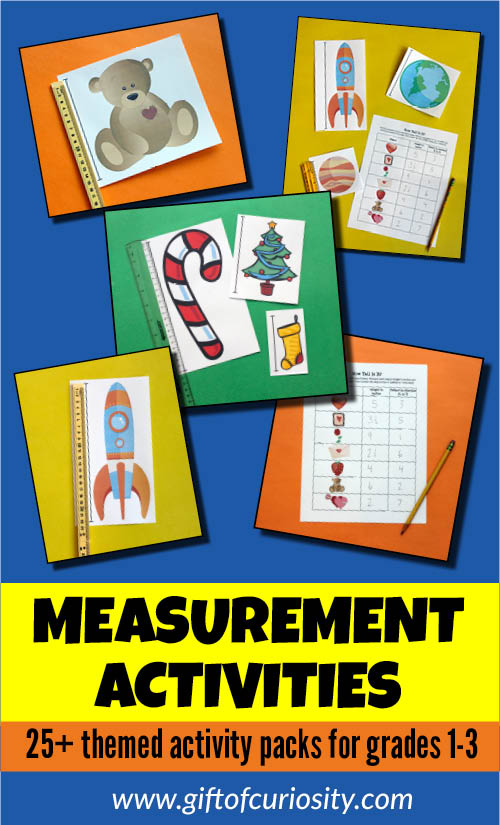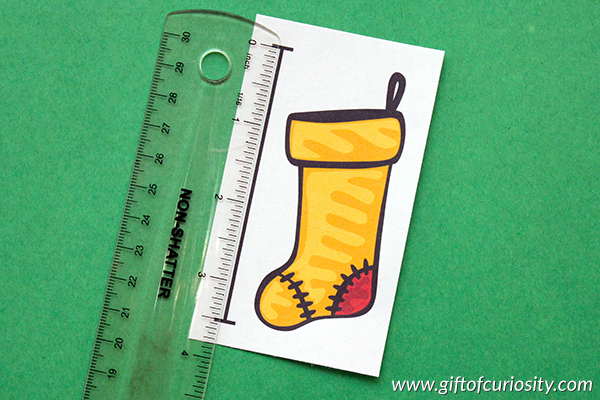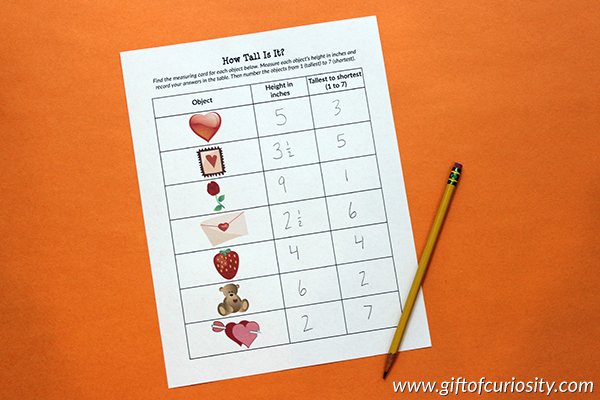This post may contain affiliate ads at no cost to you. See my disclosures for more information.
Measurement is the assignment of a numerical value to describe some characteristic of an object, such as its length, weight, or volume.
Children begin to understand concepts of measurement early on when they compare one object to another. For example, a child may ask for the larger slice of pizza, they may fill two glasses to have equal amounts of water, or they may notice that one ball is heavier than another.
In preschool, kindergarten, and even into first grade, it is common for children to measure objects with what are called non-standard units. These are units that are invented and will vary from person to person.
For example, a child may use footsteps to measure the length of a room. Of course, the child may find that the room is 30 steps long while a grown up may find that it is only 20 – hence the reason these are non-standard units.
Standard units, on the other hand, are units that are are universally available and are the same size for everyone. These include units for length such as inches and centimeters, units for volume such as gallons and liters, and units for weight such as pounds and kilograms. The ultimate goal is for children to understand and use standard units of measurement.
To give children practice using inches and centimeters to measure length, I have created a Measurement Activity Packs Bundle.
The print-and-play activities in this bundle are going to make life so much easier for you!
When you purchase this bundle you will have more than 25 different themed measurement activity packs you can pull out at different times of the year to help your children work on measuring length.
Note: For more kid-friendly math ideas, see my Math Activities for Kids page.

The printables in my Measurement Activities Pack are designed to be used by children who know their numbers and are ready to use a ruler to measure objects.
All of the activities in this pack include options for measuring objects in either inches or centimeters. Once you download the files, you simply choose the option that you wish to use with your child.
For example, your child can measure the heart in inches. This heart measures 5 inches tall.

When measuring in inches, your child can practice identifying half inches as well. This stocking, for example, measures 3 and 1/2 inches tall.

Children can also measure items in centimeters. This rocket measures 22 centimeters tall.

Because of the small nature of centimeters, children measuring in centimeters will only measure objects in whole centimeters rather than fractions of a centimeter.
One of my favorite aspects of these measurement activities are the worksheets. Kids will record the height of all the objects they measure on a worksheet. (Separate worksheets are included for inches and centimeters.)
After measuring all the objects, kids will rank them in order from tallest to shortest.

So not only do these activities work on measurement skills, they work on ordering skills as well.
While there are core academic skills are at the heart of this activity, it is my hope that kids will be far too engaged with the hands-on nature of the activity to notice that they are “working.” I developed this activity to be fun and playful for kids.
Want a copy of my Measurement Activity Pack Bundle?
Add this product to your cart by clicking the button below.
More resources for teaching math
More math activities from Gift of Curiosity:
- Build a 3D rainbow measurement activity
- Rotational symmetry activities
- Adding with chain links
- Matching and ordering by size
- Venn diagram sorting practice
- Advanced patterns worksheets





